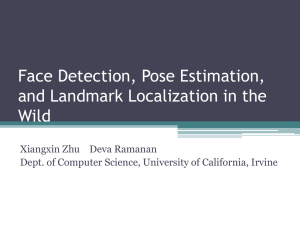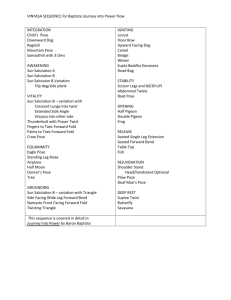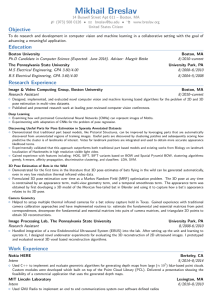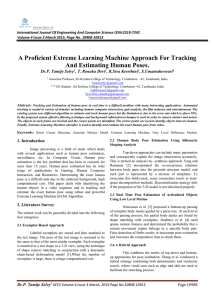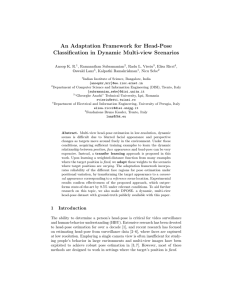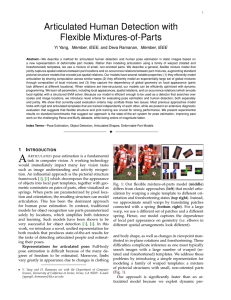HUMAN POSE ESTIMATION Narendran Anil EENG 512 Computer Vision
advertisement
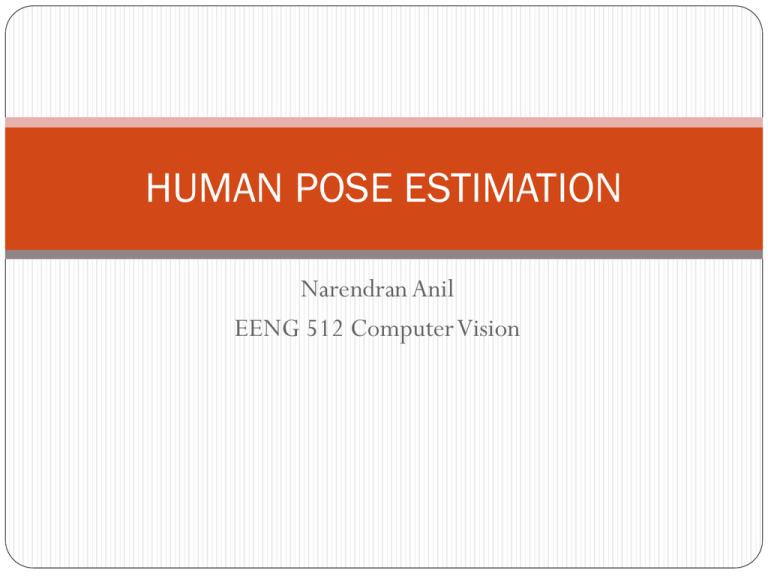
HUMAN POSE ESTIMATION
Narendran Anil
EENG 512 Computer Vision
Introduction
Human pose estimation involves the estimation of the human
body from an image.
This process recovers the relative positions and orientations
of body parts by analyzing the image.
Introduction (cont.)
Human pose estimation result
(http://www.robots.ox.ac.uk/~tvg/projects/rf_pose_det/)
Challenges
The human body pose is not easy to predict.
The pose of the human body keeps changing continuously
while performing activities like walking or running.
The pose of the human body does not follow any known
algorithm unlike mechanical systems.
Approach
The most popular method used for human pose estimation is
a model based approach.
The human body is visualized as a tree.
The body parts are vertices.
Joints are the edges.
Human model tree
H – Head
T – Torso
RUA – Right upper arm
RLA – Right lower arm
LUA – Left upper arm
LLA – Left lower arm
RUL – Right Upper leg
RLL – Right Lower leg
LUL – Left Upper leg
LLL – Left Lower leg
Model based methods
There are predominantly two ways to perform model based
pose estimation on the image
1. Top-down method
2. Bottom-up method
Top-down approach
The torso (root) is detected first
Rest of the body parts are found once the torso is detected.
Eg: Pictorial structures algorithm
This involves an energy minimization problem described as
Maximum a posteriori (MAP)
This detects only a best match of the human model in an
image
Pictorial Structures Algorithm
The pictorial structures algorithm considers the human body
as a graph with the vertices denoting the body parts and the
edges showing the connections between the parts.
It then finds the energy minimization for finding all the parts
of the human body.
L* is the energy minimization
is the cost of locating part ‘i’ at location ‘l’
is the cost of locating parts ‘i’ and ‘j’ at li and lj
based on their relative locations
These cost functions can be specified as Bayesian probability
functions and the above minimization becomes a MAP
estimation problem
Bottom-up approach
Detects potential parts first irrespective of hierarchy and
builds up the pose from bottom of the tree and then moving
upwards.
This algorithm has two steps
1.
2.
Part detection
Pose estimation of detected parts
Part detection
This is accomplished by using a contour detection algorithm.
The parts are characterized by a pair of line segments –
boundary of the part in question
Part Detection (cont.)
For contour detection, Pb operator is used
Pb operator computed the probability of the boundary at
each pixel in the image by analyzing the texture, brightness
and color around that pixel.
Part detection is performed by using a logistic classifier.
(NETLAB toolbox)
Pose is calculated by integer quadratic programming
(Optimization toolbox)
Results
These are the results obtained by applying the bottom up
method on a set of test images
The boundary detection (Pb operator) is done by using
Berkeley Segmentation Engine
Logistic Classifier from Netlab toolbox for Matlab
Integer Quadratic Programming by using Matlab’s
optimization toolbox.
Reference
[1] Lucas, B., and Kanade, T. An iterative image registration technique with an application to stereo
vision. In IJCAI81 (1981), pp. 674-679.
[2] Srinivasan, P., and Shi, J. Bottom-up recognition and parsing of the human body. In IEEE
Conference on Computer Vision and Pattern Recognition (CVPR) (2007).
[3]Ren, X., Berg, A. C., and Malik, J. Recovering human body con_gurations using pairwise
constraints between parts. In ICCV '05: Proceedings of the Tenth IEEE Inter-national Conference
on Computer Vision (ICCV'05) Volume 1 (Washington, DC, USA,2005), IEEE Computer Society,
pp. 824-831.
[4]Ramanan, D. 'Learning to parse images of articulated bodies. In Advances in Neural Information
Processing Systems 19', B. Sch• olkopf, J. Platt, and T. Ho_man, Eds. MIT Press, Cambridge, MA,
2007, pp. 1129-1136.
[5]Levin, A., and Weiss,Y. 'Learning to combine bottom-up and top-down segmentation.‘ In ECCV
(4) (2006), pp. 581-594.
[6] Bray, M., Kohli, P., and Torr, P. H. S. Posecut: 'Simultaneous segmentation and 3D pose
estimation of humans using dynamic graph-cuts.' In ECCV (2) (2006), pp. 642{655.
[7] Antani, L. and Chandran, S. 'Skeleton-Based Pose Estimation of Human Figures.' Department of
Computer Science and Engineering, Indian Institute of Technology, Bombay
[8] Felzenszwalb, P. F., and Huttenlocher, D. P. 'Pictorial structures for object recognition.‘ Int. J.
Comput. Vision 61, 1 (2005), 55-79.
